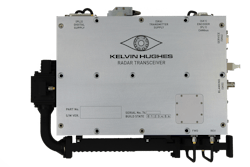The Royal Canadian navy will be upgrading the navigation radar systems in two of its Victoria-class long-range patrol submarines, replacing older model 1007 systems from Kelvin-Hughes with that company’s SharpEye downmast submarine navigation versions (see photo). The solid-state SharpEye system features an I-band transceiver that works with the existing navigation radar bulkhead infrastructure and external antenna, rotational drive system, and waveguide interconnections.
The solid-state SharpEye radar systems employ Doppler processing of radar returns for long-range detection with less transmit power than magnetron-based vacuum-electronics radar systems. For example, legacy submarine radar systems employ transmitters operating with about 25 kW power, while the solid-state SharpEye systems can illuminate targets across a long distance with 300 W or less transmit power.
A solid-state navigation radar system is replacing two higher-powered radar systems in a pair of long-range submarines for the Royal Canadian Navy. (Courtesy of Kelvin-Hughes LLC)
By using a series of signal filters, the radar system can differentiate between different targets, including those with relatively low radar cross section (RCS). The advanced signal processing also helps the SharpEye radar systems to detect targets surrounded by signal clutter and in adverse weather conditions.
“This upgrade for the Royal Canadian Navy is a further example of the growing interest in our SharpEye downmast submarine variant,” noted Adrian Pilbeam, vice president of Kelvin Hughes LLC, “and highlights the need for submarines to be equipped with modern high-performance radar rather than the legacy magnetron systems that many of them are still using.”
About the Author
Jack Browne
Technical Contributor
Jack Browne, Technical Contributor, has worked in technical publishing for over 30 years. He managed the content and production of three technical journals while at the American Institute of Physics, including Medical Physics and the Journal of Vacuum Science & Technology. He has been a Publisher and Editor for Penton Media, started the firm’s Wireless Symposium & Exhibition trade show in 1993, and currently serves as Technical Contributor for that company's Microwaves & RF magazine. Browne, who holds a BS in Mathematics from City College of New York and BA degrees in English and Philosophy from Fordham University, is a member of the IEEE.


